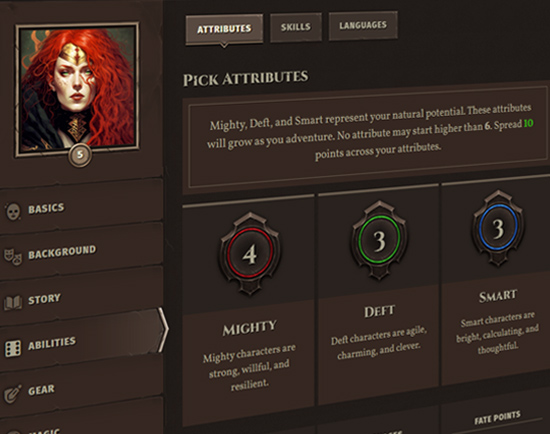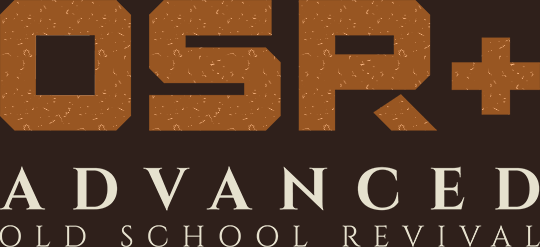Now that you've decided the scope of your adventure and whether it will be linear or nonlinear, you can start creating the scenes and adventure hooks that will make it all come together as a sandbox.
In a nutshell, an adventure is made up of a handful of scenes connected by adventure hooks. There are many different types of scenes and adventure hooks, but ultimately scenes are the where and when of the fiction and hooks are the how and why.
As players explore scenes, they uncover hooks that point them in the direction of other scenes. In this way, players are in charge of how the adventure unfolds, as they get to make decisions about where to go based on the hooks they discover in each scene.
Scenes
At its heart, a scene is a self-contained situation for players to explore, usually a physical location. The adventure is made up of scenes connected together by adventure hooks, so each scene is a self-contained situation that exists to yield adventure hooks which help players decide what scene to go to next.
A scene can have any number of adventure hooks pointing to other scenes, but as a rule of thumb, each scene in your adventure needs at least three hooks that point to it from other scenes. This is to help reinforce players' awareness of the scene's existence.
Adventure Hooks
Adventure hooks are narrative clues that "hook" the players into exploring other scenes. They create incentives for players to explore the content you designed for them, giving your scenes a natural fictional "gravity," because the more hooks they uncover that point to a scene, the more "presence" the scene has in their minds.
Hooks can be presented in a number of formats, such as information about the scene or the events occurring in it, or as physical artifacts that indicate the same, but they primarily exist to communicate that other scenes in the adventure exist and remain to be explored.
Ideally, every scene yields several hooks to other scenes. This means that as you design your scenes, you need to think about ways in which each scene can plausibly indicate a few other scenes. It's OK if players uncover hooks to scenes they've already explored: that redundancy is a good thing, because it reinforces their understanding of the adventure's "big picture."
Why Scenes & Hooks?
The inherent nonlinearity of designing adventures this way will make life easier for you, both in prepping for the adventure and in maximizing players' enjoyment of the game. You won't have to write up endless contingencies outlining your course of action if the players do this or that: by organizing the adventure into scenes connected together by hooks, you've already accounted for their agency in the structure of the environment. Like pinballs in an arcade machine, your players get to bounce around the adventure unpredictably, but in the predictable context of the scenes you created.
Maximizing Meaningful Choice
On the one hand, you get to sit back and react to what the players do, since they're the ones making the decisions about where to go next based on the hooks they discover. While you still have some leverage over the adventure through pacing and the strategic deployment of floating scenes, you maximize their opportunities to make meaningful choices in the context of the adventure by privileging their agendas over your own.
Strategic Prep
Once you've laid out all the scenes you need for your adventure, you have a clear picture of all the mechanical stuff you need to prep to handle just about any situation. Add to this that your prep naturally gets organized by scene, so you can grab exactly the prep you need the moment players enter a scene.
A single scene might require the following prep:
- A map or visual aid of the space if a combat encounter might take place (though this isn't strictly necessary, as combat in OSR+ can be handled in the theater of mind, most of the time);
- Shorthand for NPCs or monsters that require stats;
- The adventure hooks;
- Any unique treasure or items;
- The stats for any known perils.
On Boundaries of Play
As you design the adventure, you may have a niggling question of what to do if your players try to exit the boundaries of your adventure in the back of your mind.
We addressed this to some degree in the what ifs of linear vs. nonlinear play, but let's now look at those what ifs in practice.
Suppose at the gates of Glenluce in Monsters of Merovia, your players decide they don't want to go into the town. Instead, they'd prefer to leave the scenario and travel north to join the Dread Lords in their conquest of Merovia.
There's a couple of responses to this impulse to consider:
- First, there's the social contract. Everyone at the table agreed to the premise of Monsters of Merovia in session zero (or, in the absence of session zero, when you presented your pitch deck or setting overview). Monsters is a short that features adventurers exhausted from dangerous travel, who take refuge in Glenluce because they have nowhere else to turn. If your table suddenly doesn't want to play that game, they're violating the social contract by rejecting the enjoyment you get out of the game: running what you want to run as a GM. It's acceptable to tell them that this is not the adventure you designed for them, and if they want to reject the premise, then they'll have to play a different game.
- Second, there's a matter of prep, which is unavoidable. If this were a campaign and not a short (and so there is a wider world to explore that would dovetail with other adventures you have yet to design), the party might be warranted in exiting the boundaries of the adventure, for reasons that make sense in the context of the fiction. In this case, it's OK to say that you need to end the session to prep for where this new direction in the campaign is going. The good thing is that because your adventure was designed in a nonlinear fashion, you can cannibalize your scenes and put them into other adventures.
Both of these responses are abortive in nature, and that's because at its heart, OSR+ is a simulationist game.
While there are mechanics in the game that help you improvise things out of thin air, the world exists out there to be discovered. Mysteries have definite answers that can be uncovered with pre-existing clues, and factions are up to stuff independent of what the PCs are doing. Without a certain amount of prep to make the world feel free, meaningful choice becomes a bit of an illusion, reduced to the whims of GM who's just making things up as he goes along.
 Archetypes
Archetypes Armor
Armor Classes
Classes Conflicts
Conflicts Cultures
Cultures Ethos
Ethos Flaws
Flaws Glossary
Glossary Kits
Kits Maleficence
Maleficence Origins
Origins Shields
Shields Skills
Skills Spells
Spells Stances
Stances Status Effects
Status Effects Tactics
Tactics Talents
Talents Techniques
Techniques Treasure
Treasure Weapons
Weapons











 Hall of Heroes
Hall of Heroes Hall of Legends
Hall of Legends



 Dungeons & Flagons
Dungeons & Flagons